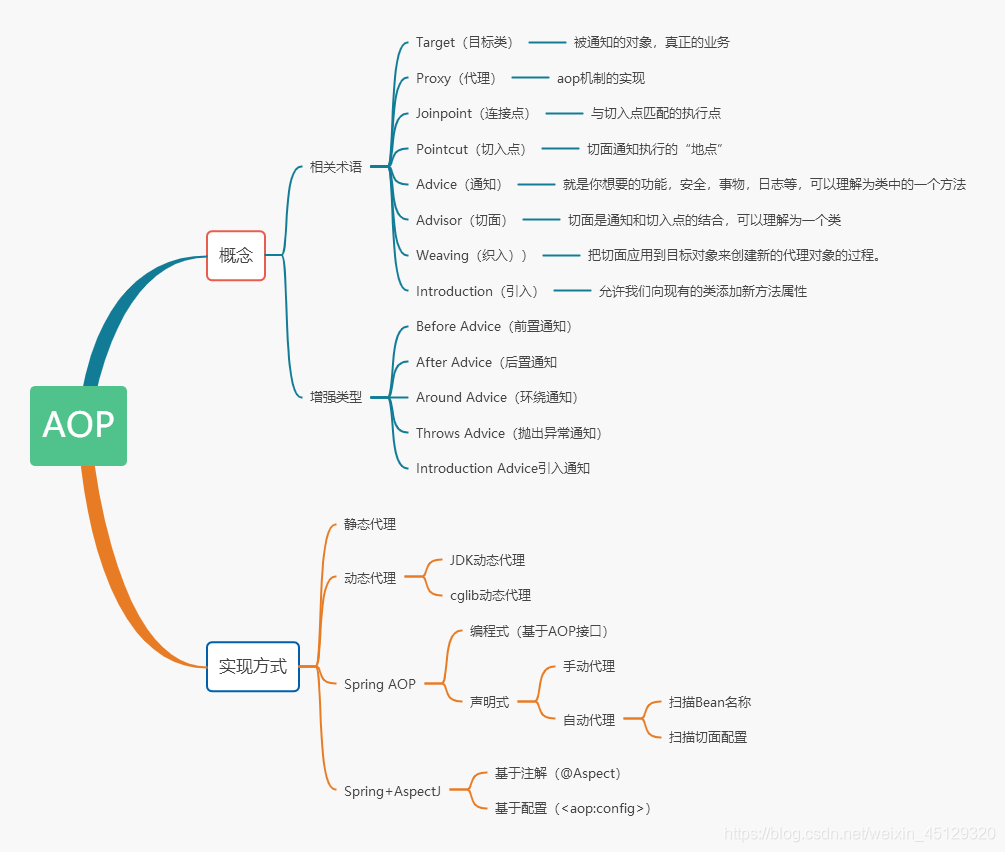Spring AOP的三种实现方式
2020-06-24 04:33
141 查看
AOP实现方式

1.AOP环境配置

Maven中的导入:
<dependencies> <dependency> <groupId>org.aspectj</groupId> <artifactId>aspectjweaver</artifactId> <version>1.9.4</version> </dependency> <dependency> <groupId>org.springframework</groupId> <artifactId>spring-webmvc</artifactId> <version>5.2.5.RELEASE</version> </dependency> <dependency> <groupId>junit</groupId> <artifactId>junit</artifactId> <version>4.12</version> </dependency> </dependencies>
2.AOP实现方式一:使用Spring的API接口
- 定义一个接口:
package com.lin.service;
public interface UserService {
public void insert();
public void delete();
public void update();
public void select();
}
- 创建要被代理的UserServiceImpl类,代码如下:
package com.lin.service;
public class UserServiceImpl implements UserService {
public void insert() {
System.out.println("增加一个客户");
}
public void delete() {
System.out.println("删除一个客户");
}
public void update() {
System.out.println("修改一个客户");
}
public void select() {
System.out.println("查询一个客户");
}
}
3.编写AOP的通知类Log
package com.lin.log;
import org.springframework.aop.AfterReturningAdvice;
import org.springframework.aop.MethodBeforeAdvice;
import java.lang.reflect.Method;
public class Log implements MethodBeforeAdvice, AfterReturningAdvice {
//method 要执行目标对象的方法
//args 参数
//target 目标对象
public void before(Method method, Object[] args, Object target) throws Throwable {
System.out.println(target.getClass().getName()+"的"+method.getName()+"方法,被执行了");
}
//returnValue 执行方法后的返回值
public void afterReturning(Object returnValue, Method method, Object[] args, Object target) throws Throwable {
System.out.println("执行了"+method.getName()+"方法,返回的值为"+returnValue);
}
}
4.配置容器初始化时需要的log.xml文件
<?xml version="1.0" encoding="UTF-8"?> <beans xmlns="http://www.springframework.org/schema/beans" xmlns:xsi="http://www.w3.org/2001/XMLSchema-instance" xmlns:aop="http://www.springframework.org/schema/aop" xsi:schemaLocation="http://www.springframework.org/schema/beans https://www.springframework.org/schema/beans/spring-beans.xsd http://www.springframework.org/schema/aop https://www.springframework.org/schema/aop/spring-aop.xsd"> <!--注册通知类--> <bean id="log" class="com.lin.log.Log"/> <!-- 注册被代理对象 --> <bean id="userService" class="com.lin.service.UserServiceImpl"/> <!--配置aop:需要导入aop约束--> <aop:config> <!--切入点:expression:表达式 execution(要执行的位置)--> <aop:pointcut id="pointcut" expression="execution(* com.lin.service.UserServiceImpl.*(..))"/> <!--执行环绕增加--> <aop:advisor advice-ref="log" pointcut-ref="pointcut"/> </aop:config> </beans>
5.测试类MyTest.java代码如下:
import com.lin.service.UserService;
import com.lin.service.UserServiceImpl;
import org.springframework.context.ApplicationContext;
import org.springframework.context.support.ClassPathXmlApplicationContext;
public class MyTest {
public static void main(String[] args) {
//如果是web项目,则使用以下代码加载配置文件,如果是一般的Java项目,则使用注释的方式
ApplicationContext context = new ClassPathXmlApplicationContext("aop.xml");
// ApplicationContext context = new FileSystemXmlApplicationContext("XML文件的绝对路径...");
UserService userService = (UserService) context.getBean("userService");
userService.delete();
}
}
3.AOP实现方式二:自定义(切面) 实现AOP
1.创建一个自定义通知类
package com.lin.diy;
public class Diy {
public void before(){
System.out.println("========方法执行之前===========");
}
public void after(){
System.out.println("========方法执行之后===========");
}
}
2.XML配置部分
<bean id="userService" class="com.lin.service.UserServiceImpl"/> <bean id="diy" class="com.lin.diy.Diy"/> <aop:config> <!--自定义切面,ref要引用的类--> <aop:aspect ref="diy"> <!--切入点和通知的结合就是切面--> <!--切入点--> <aop:pointcut id="point" expression="execution(* com.lin.service.UserServiceImpl.*(..))"/> <!--通知--> <aop:before method="before" pointcut-ref="point"/> <aop:after method="after" pointcut-ref="point"/> </aop:aspect> </aop:config>
3.测试类
import com.lin.service.UserService;
import com.lin.service.UserServiceImpl;
import org.springframework.context.ApplicationContext;
import org.springframework.context.support.ClassPathXmlApplicationContext;
import org.springframework.context.support.FileSystemXmlApplicationContext;
public class MyTest {
public static void main(String[] args) {
//如果是web项目,则使用以下代码加载配置文件,如果是一般的Java项目,则使用注释的方式
ApplicationContext context = new ClassPathXmlApplicationContext("aop.xml");
// ApplicationContext context = new FileSystemXmlApplicationContext("XML文件的绝对路径...");
UserService userService = (UserService) context.getBean("userService");
userService.delete();
}
}
4.AOP实现方式三:注解
1.利用注解定义一个通知类
package com.lin.diy;
import com.lin.service.UserService;
import com.lin.service.UserServiceImpl;
import org.aspectj.lang.ProceedingJoinPoint;
import org.aspectj.lang.annotation.*;
@Aspect
public class AnnotationApo {
//定义切入点
@Pointcut("execution(* com.lin.service.UserServiceImpl.*(..))")
private void cutPoint(){}
@Before("cutPoint()") //等于@Before("* com.lin.service.UserServiceImpl.*(..)"),置前
public void before(){
System.out.println("方法执行前----------------");
}
@AfterReturning("execution(* com.lin.service.UserServiceImpl.*(..))")
//等于@AfterReturning("cutPoint()"),带有返回值置后
public void after(){
System.out.println("方法执行后----------------");
}
@Around(("cutPoint()")) //环绕通知
public Object doBasicProfiling(ProceedingJoinPoint pjp) throws Throwable{
System.out.println("进入环绕通知");
Object object = pjp.proceed();//执行该方法
System.out.println("退出方法");
return object;
}
}
2.xml配置文件
<?xml version="1.0" encoding="UTF-8"?> <beans xmlns="http://www.springframework.org/schema/beans" xmlns:xsi="http://www.w3.org/2001/XMLSchema-instance" xmlns:aop="http://www.springframework.org/schema/aop" xsi:schemaLocation="http://www.springframework.org/schema/beans https://www.springframework.org/schema/beans/spring-beans.xsd http://www.springframework.org/schema/aop https://www.springframework.org/schema/aop/spring-aop.xsd"> <!--开启注解支持,默认情况下proxy-target-class="false",基于JDK实现;true,基于cglib实现--> <aop:aspectj-autoproxy proxy-target-class="true"/> <!--注册bean--> <bean id="userService" class="com.lin.service.UserServiceImpl" /> <bean id="annotation" class="com.lin.diy.AnnotationApo" /> </beans>
3.测试类
import com.lin.service.UserService;
import org.springframework.context.ApplicationContext;
import org.springframework.context.support.ClassPathXmlApplicationContext;
public class MyTest {
public static void main(String[] args) {
//如果是web项目,则使用以下代码加载配置文件,如果是一般的Java项目,则使用注释的方式
ApplicationContext context = new ClassPathXmlApplicationContext("aop.xml");
// ApplicationContext context = new FileSystemXmlApplicationContext("XML文件的绝对路径...");
UserService userService = (UserService) context.getBean("userService");
userService.delete();
}
}
5.总结
Spring AOP 通过 CGLIB或者JDK代理 来动态地生成代理对象,这个代理对象指的就是 AOP 代理类,而 AOP 代理类的方法则通过在目标对象的切入点动态地织入增强处理,从而完成了对目标方法的增强。
相关文章推荐
- Spring aop实现的三种方式
- Spring AOP的三种实现方式
- Intent实现Activity跳转的三种方式
- 三种方式实现生产者和消费者模式
- iOS中三种方式实现登录界面播放视频或gif效果
- 分布式锁的三种实现方式
- 详细解读分布式锁原理及三种实现方式
- Android-底部菜单Tabs 三种实现方式(ViewPager,Fragment,ViewPage+Fragment)
- nginx限流方案的实现(三种方式)
- 单点登录的三种实现方式
- java使用递归,非递归方式实现二叉树的三种常见遍历方式
- Android三种方式实现视频
- android 三种实现水平向滑动方式(ViewPager、ViewFilpper、ViewFlow)的比较
- Java-多线程三种实现方式
- Android跑马灯效果实现的三种方式
- 三种 bottom half的实现方式 softirqs, tasklets, work queue 及之间的比较 ,驱动程序使用tasklet机制
- 三种方式实现圆角图片
- JAVA多线程实现的三种方式
- Android TextView实现带链接文字事件监听的三种常用方式示例
- 总结:三种方式实现单击页签切换页面效果
